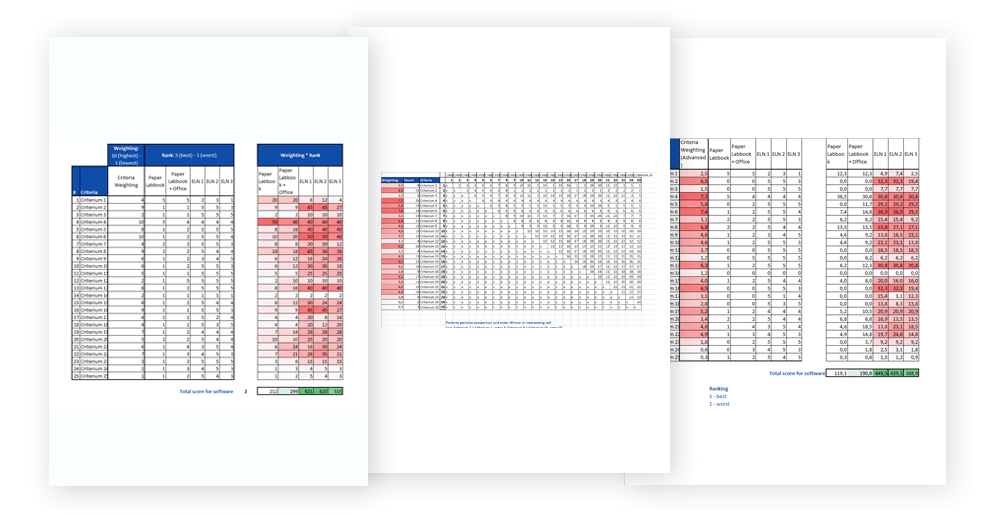The value of an electronic lab notebook – on ROI and stakeholder buy-in
![]() 7 min read
7 min read
Making a tech investment is a major decision, especially if the decision will affect most, if not all members within the company. A return on investment (ROI) assessment can be a useful tool to help identify the resources necessary (investment), and the benefits you will receive (return). The analysis can also strengthen the case for the investment.
Use the following as a guide to help you determine the ROI of implementing an Electronic Lab Notebook (ELN) in your organization.
Content
Determine the Return on Investment (ROI)
ROI can be considered as an assessment of “how much profit has been generated from an investment that’s been made.” A calculation of the anticipated ROI is a fairly standard practice for businesses and can often help guide decision-making. It answers the question – “Is this investment really worth it?”
For example, if you are about to make a significant purchase – like a car – you would want to think about the investment (cost of the car and gasoline/electricity to power the car, time it takes to be familiar with the car) and the return (money saved on transportation or shipping/delivery when you can pick up, time saved from commuting).
Some other decisions might be a lot more intuitive – like getting a desk lamp – where you know pretty quickly what the benefits are without an actual calculation. In the case where you are calculating the ROI of a project, such as purchasing an ELN, the formula could be written as:
ROI = [(Financial Value – Project Cost) / Project Cost] x 100
Tim Stobierski, writer for the Harvard Business School Online blog, provided a great example of calculating the ROI of selling chocolate bars to a grocery store. It is worth noting that the financial returns for an ELN is not exactly straightforward. As noted by a white paper on E-Notebook ROI by CambridgeSoft,
“In considering all financial returns, it is necessary to introduce a distinction between returns resulting from cost saving and those resulting from productivity gain. In the former case, investments in technology result in a near-term expenditure reduction. In the latter case, it is more often true that technology allows organizations to do more with the same as opposed to doing the same with less.”
Both cases play important roles in the determination of ROI for an ELN.
The financial returns of an ELN investment
Let’s first start with the kind of benefits you can see when implementing an ELN. In an ROI calculation, you can estimate the return by multiplying the amount of time saved by the hourly cost of the task. You should also determine the timeframe for such a calculation, as investments with long-term returns might not be reflected within a short timeframe (e.g., a tool that might require more short-term training that could be outweighed by significant future benefits).
Day-to-day activities
“Paper notebooks can be an inexpensive medium, but executing actions that are trivial with an ELN (e.g., searching, sharing and data backup) are time expensive.”– Nature Protocols, Stuart Higgins, Akemi Nogiwa-Valdez, and Molly Stevens, Nature Protocols
Saving time from day-to-day activities is likely the most obvious return for implementing an ELN. Depending on the features available, day-to-day productivity benefits could include:
- Document experimental protocols and data
- Create experiment templates and protocols for sharing and distribution
- Help plan research projects and experiments
- Reducing the time to onboard new employees
- Improve agile responses and collaborations
- Reduced time required for report generation
- Locate experiments, protocols, and results quickly
- Reduce the storage space required to house paper notebooks
- Improve lab management (inventory and stock, team/HR)
In our own user analysis, researchers can save on average 9 hours a week after the implementation of SciNote; most of the efficiency improvements were found in emails, scheduling/planning, reporting, manuscript writing, and research. Another company saw their clients’ use of E-notebook results in productivity boosts at 25% for data entry and 50% for reporting, resulting in a cost saving of 20K/user/year.
Get the weighted ELN selection template used by NEUWAY Pharma:
Compliance needs
Whether you are filling for patents, meeting regulatory agency guidelines (FDA 21 CFR Part 11 or GxP), or preparing for grant agency data management needs (NIH and EU), it takes a significant amount of time to locate all the documents and to comply with the requirements.
In these cases, it is important not just to keep the records, but also to keep the records in the right way, with the necessary information. For example, where data integrity matters, it is expected that data should be attributable, legible, contemporaneously recorded, original or a true copy. In other cases where data sharing is expected, the FAIR principles (findable, accessible, interoperable and reusable) should be followed.
Because these efforts will take a lot more time, an ELN with features that can help organizations meet compliance needs will generate a larger ROI. Also make sure to consider the delay caused by missing documentation or violation of requirements – estimate the additional time (and cost) it might take to recover from these challenges.
Tech Transfer
Tech transfer is another place where using an ELN can result in a significant ROI. Consider the time it takes to develop protocols, to track experimental conditions, or to ensure SOPs are reproducible. This is perhaps the most critical one for a company that’s just starting up, or planning to scale up, or hoping to reduce its own research costs by contracting out to a CDMO/CRO.
Rita Cruz from Ingenza Ltd, a UK biotech company specializing in the design, development and manufacture of diverse, high-value industrial products and therapeutic-proteins, discussed the importance of using an ELN in scaling up their processes.
The associated costs of an ELN investment
Now let’s look at the overall investments required when implementing an ELN. Some are cost-related considerations, while others are time-related considerations:
- Fee: Is the cost a one-time fee or a monthly/annual fee? What’s the timeframe for the fee?
- Add-ons: Does the product come with all the features you need? Are there additional costs for add-ons? For products that allow you to build your own add-ons, how much time will need to be invested in building and maintaining them?
- Training: Does the product come with onboarding training? Or will it cost extra? If no training is included, does the product come with training materials? How much time will it take staff to self-train?
- Adaptation: How long will it take for lab members to be proficient with the ELN? How much time will it take them to participate in training activities?
- Maintenance and upkeep: Who will be responsible for maintaining and updating the ELN? Can you get support quickly if you run into technical issues?
- Hardware: Do lab members have access to electronic devices for using ELN? If not, purchases of such devices might need to be considered.
- Integrations: Can the ELN fit into the existing lab environment? If the ELN has the capacity for integrations, does the lab have resources to set up such integrations?
There are a few ways you can minimize the investment to give you a great ROI:
- Make sure to select the ELN that best fit your needs, and plan ahead as to how the implementation will be rolled out.
- Consider cloud-based options, as this can significantly reduce the cost of maintenance and upkeep.
- Look for a provider that offers good customer support, as this will bring down the cost of training and the time it takes for adaptation.
Make the case for an ELN investment
“Price is what you pay; value is what you get.” – Warren Buffett
After factoring in the values and costs of an ELN investment, you can now estimate its anticipated ROI. In cases where some of these are not quantifiable, or where a full ROI calculation can’t be done, there are additional ways to provide some context and make a case for an investment in an ELN.
- Identify your needs, and use this free Excel template to evaluate various ELN options
- Talk to the vendors directly; some will be able to provide references to customers with similar use cases
- Look for use cases on the vendor’s website to see if you can identify similar use cases
- Do a trial with the vendor to see if the ELN fits your needs
In deciding whether to invest in an ELN, an ROI analysis could be a great tool to evaluate your needs, and to identify the best option for moving forward. What other considerations do you have when it comes to investing in an ELN?

If you like this post also check out
- Return on Investment When Implementing an Electronic Lab Notebook
- How to calculate ROI to justify a project via Harvard Business School Online
- Successfully Advocating for Investments in the Lab via Lab Manager
- Electronic Laboratory Notebooks Progress and Challenges in Implementation via SLAS Technology
- E-Notebook ROI (Return On Investment) by CambridgeSoft
Need help figuring out your ROI?
Talk to our team & get the top-rated customer service in the ELN industry.





